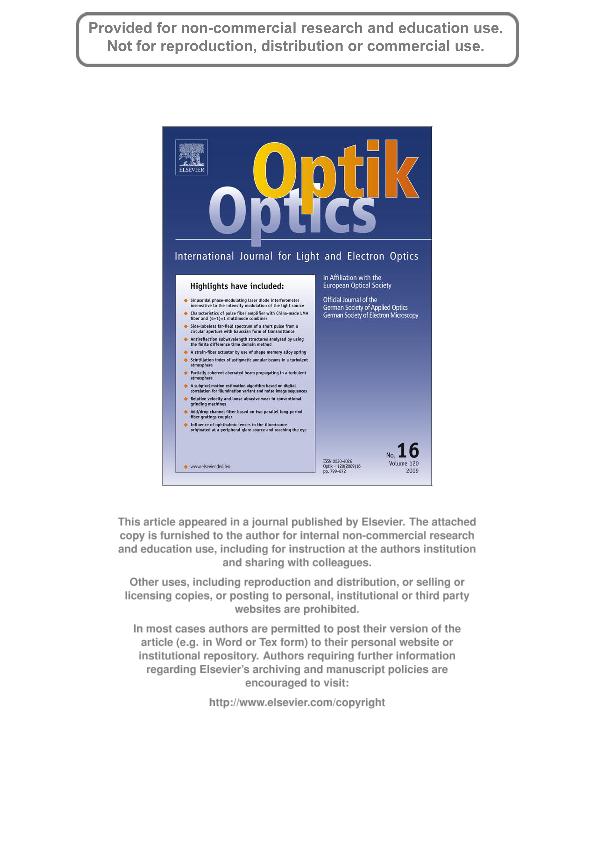Mostrar el registro sencillo del ítem
dc.contributor.author
Comastri, Silvia Ana Elva

dc.contributor.author
Matranga, Juliana

dc.contributor.author
Bastida, Karina

dc.contributor.author
Issolio, Luis Alberto

dc.contributor.author
Colombo, Elisa Margarita

dc.date.available
2020-02-10T18:07:51Z
dc.date.issued
2009-11
dc.identifier.citation
Comastri, Silvia Ana Elva; Matranga, Juliana; Bastida, Karina; Issolio, Luis Alberto; Colombo, Elisa Margarita; Influence of ophthalmic lenses in the illuminance originated at a peripheral glare source and reaching the eye; Elsevier Gmbh; Optik; 120; 16; 11-2009; 860-872
dc.identifier.issn
0030-4026
dc.identifier.uri
http://hdl.handle.net/11336/97080
dc.description.abstract
To study the influence of glare on the visual performance of a subject wearing an ophthalmic lens, it is useful to know how the lens affects the illuminance reaching the eye. In this paper, considering spherical standard ophthalmic lenses and defining the relative illuminance, Er, as the quotient between the illuminance at the cornea with and without lens, a methodology to evaluate Er in terms of easily determined parameters is developed. Three effects are considered, pupil size variation of the system with and without lens; lateral shifts of rays transmitted through the lens and reflections at the lens. Calculations are experimentally verified employing 5 organic ophthalmic lenses of ±6; ±4 and 0.12 dioptres and 2 glass plane parallel plates 1.95 and 6.6 mm thick. Using a photometer whose sensor is 12 mm apart from the lens and 740 mm apart from a glare source subtending an eccentricity angle of 9.6°, it results Er=1.204 for the 6 dioptres lens and Er=0.803 for the -6 dioptres one if sensor diameter is 10 mm while, for a 719 mm distance and a 10° angle, Er=0.922 for the thin plate and a 30 mm sensor and Er=1.006 for the thick plate and a 10 mm sensor. Experimental and theoretical results differ in less than 3%.
dc.format
application/pdf
dc.language.iso
eng
dc.publisher
Elsevier Gmbh

dc.rights
info:eu-repo/semantics/openAccess
dc.rights.uri
https://creativecommons.org/licenses/by-nc-sa/2.5/ar/
dc.subject
GLARE
dc.subject
LATERAL SHIFTS
dc.subject
OCULAR PUPIL
dc.subject
OPHTHALMIC LENSES
dc.subject
REFLECTIONS
dc.subject.classification
Física de los Fluidos y Plasma

dc.subject.classification
Ciencias Físicas

dc.subject.classification
CIENCIAS NATURALES Y EXACTAS

dc.title
Influence of ophthalmic lenses in the illuminance originated at a peripheral glare source and reaching the eye
dc.type
info:eu-repo/semantics/article
dc.type
info:ar-repo/semantics/artículo
dc.type
info:eu-repo/semantics/publishedVersion
dc.date.updated
2019-07-02T16:26:49Z
dc.journal.volume
120
dc.journal.number
16
dc.journal.pagination
860-872
dc.journal.pais
Alemania

dc.journal.ciudad
Berlín
dc.description.fil
Fil: Comastri, Silvia Ana Elva. Universidad de Buenos Aires. Facultad de Ingeniería; Argentina
dc.description.fil
Fil: J.Matranga. Universidad de Buenos Aires. Facultad de Ingeniería; Argentina
dc.description.fil
Fil: Bastida, Karina. Instituto Nacional de Tecnología Industrial; Argentina
dc.description.fil
Fil: Issolio, Luis Alberto. Consejo Nacional de Investigaciones Científicas y Técnicas. Centro Científico Tecnológico Conicet - Tucumán. Instituto de Investigación en Luz, Ambiente y Visión. Universidad Nacional de Tucumán. Facultad de Ciencias Exactas y Tecnología. Instituto de Investigación en Luz, Ambiente y Visión; Argentina. Universidad Nacional de Tucumán. Facultad de Ciencias Exactas y Tecnología. Departamento de Luminotecnia, Luz y Visión; Argentina
dc.description.fil
Fil: Colombo, Elisa Margarita. Consejo Nacional de Investigaciones Científicas y Técnicas. Centro Científico Tecnológico Conicet - Tucumán. Instituto de Investigación en Luz, Ambiente y Visión. Universidad Nacional de Tucumán. Facultad de Ciencias Exactas y Tecnología. Instituto de Investigación en Luz, Ambiente y Visión; Argentina. Universidad Nacional de Tucumán. Facultad de Ciencias Exactas y Tecnología. Departamento de Luminotecnia, Luz y Visión; Argentina
dc.journal.title
Optik

dc.relation.alternativeid
info:eu-repo/semantics/altIdentifier/doi/http://dx.doi.org/10.1016/j.ijleo.2009.03.008
dc.relation.alternativeid
info:eu-repo/semantics/altIdentifier/url/https://www.sciencedirect.com/science/article/pii/S0030402609001211
Archivos asociados
